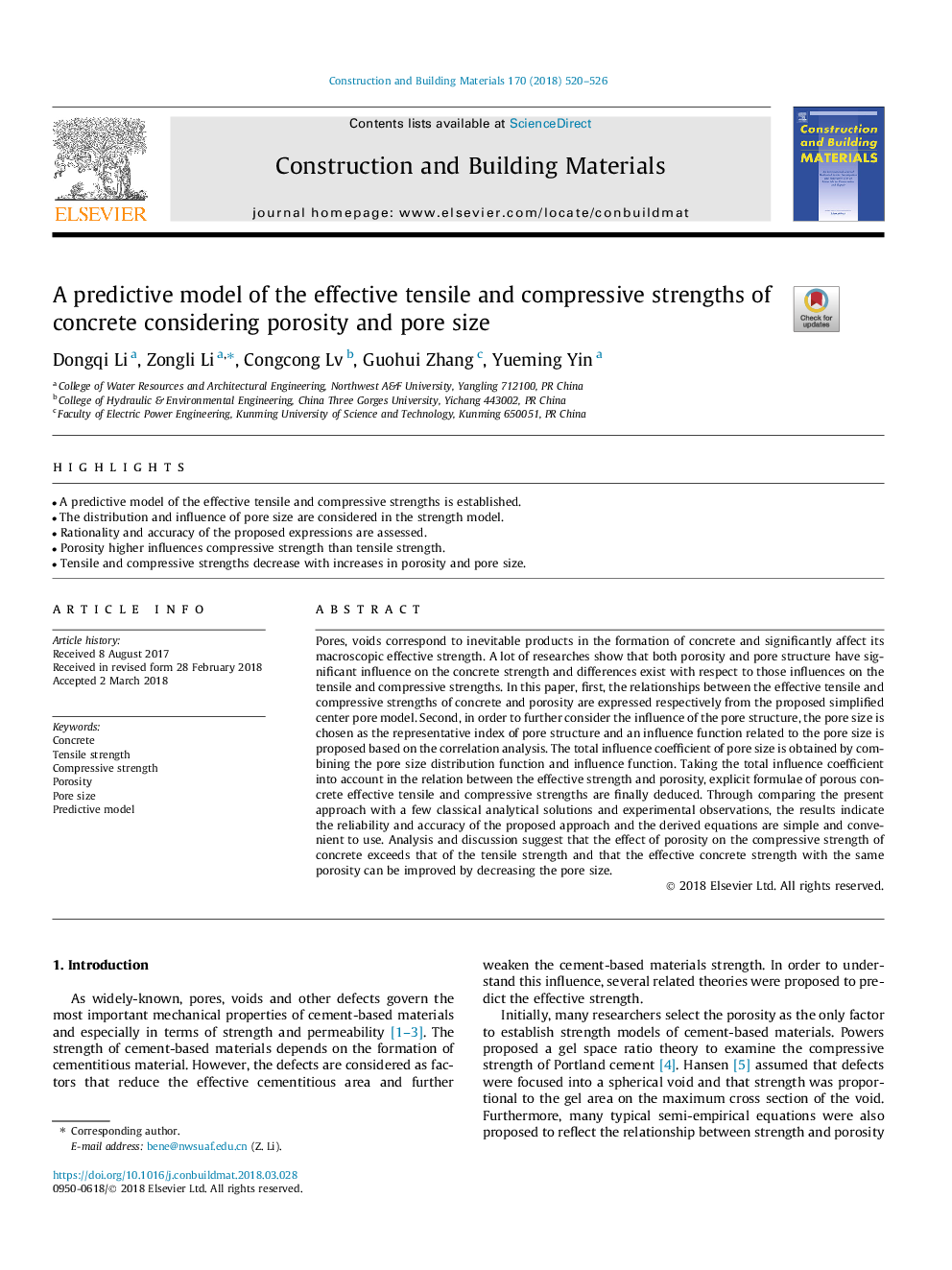| کد مقاله | کد نشریه | سال انتشار | مقاله انگلیسی | نسخه تمام متن |
|---|---|---|---|---|
| 6714228 | 1428736 | 2018 | 7 صفحه PDF | دانلود رایگان |
عنوان انگلیسی مقاله ISI
A predictive model of the effective tensile and compressive strengths of concrete considering porosity and pore size
ترجمه فارسی عنوان
یک مدل تخمینی از کشش موثر و استحکام تراکمی بتن با رویکرد تخلخل و اندازه حفره ها
همین الان دانلود کنید
دانلود مقاله ISI انگلیسی
رایگان برای ایرانیان
کلمات کلیدی
بتن، استحکام کششی، استحکام فشاری، قطر بینی، اندازه منفذ، مدل پیش بینی شده
فهرست مطالب مقاله
چکیده
کلمات کلیدی
1.مقدمه
شکل 1 :فرآیند انطباق (a) حالت تنش میکرو واحد (b) مدل ساده شده تخلخل مرکزی (c) مدل قطبی معادل b
2- استحکام موثر بتن متخلخل
2-1- مدل ساده شده تخلخل مرکزی
2-2- استحکام کششی موثر بتن متخلخل
2-3- استحکام فشاری مفید بتن متخلخل
2-4- تاثیر ساختار تخلخل بر روی استحکام فشاری و کششی مفید
شکل 2: مقایسه روش حاضر با سه روش کلاسیک
شکل 3: مقایسه بین مقاومت بدون در نظر گرفتن تخلخل با مشاهدات آزمایشگاهی Gao
3 - تایید مدل
3-1- مقایسه مدل پیشنهادی با مدلهای دیگر
3-2- تاییدات آزمایشگاهی مدل پیشنهادی
4 – بحث و نتیجه گیری
4-1- تاثیر تخلخل بر کشش و استحکام فشاری مفید
شکل 4: تاثیر تخلخل بر روی مقاومت کششی و فشاری مفید بتن
4-2- تاثیر سایز تخلخل بر روی استحکام فشاری و کششی مفید
جدول شماره 1: مقایسه بین مقاومت بدون در نظر گرفتن تخلخل با مشاهدات آزمایشگاهی Gao
جدول شماره 2: تاثیر سایز تخلخل بر روی مقاومت کششی و فشاری مفید بتن
5 – نتیجه گیری
کلمات کلیدی
1.مقدمه
شکل 1 :فرآیند انطباق (a) حالت تنش میکرو واحد (b) مدل ساده شده تخلخل مرکزی (c) مدل قطبی معادل b
2- استحکام موثر بتن متخلخل
2-1- مدل ساده شده تخلخل مرکزی
2-2- استحکام کششی موثر بتن متخلخل
2-3- استحکام فشاری مفید بتن متخلخل
2-4- تاثیر ساختار تخلخل بر روی استحکام فشاری و کششی مفید
شکل 2: مقایسه روش حاضر با سه روش کلاسیک
شکل 3: مقایسه بین مقاومت بدون در نظر گرفتن تخلخل با مشاهدات آزمایشگاهی Gao
3 - تایید مدل
3-1- مقایسه مدل پیشنهادی با مدلهای دیگر
3-2- تاییدات آزمایشگاهی مدل پیشنهادی
4 – بحث و نتیجه گیری
4-1- تاثیر تخلخل بر کشش و استحکام فشاری مفید
شکل 4: تاثیر تخلخل بر روی مقاومت کششی و فشاری مفید بتن
4-2- تاثیر سایز تخلخل بر روی استحکام فشاری و کششی مفید
جدول شماره 1: مقایسه بین مقاومت بدون در نظر گرفتن تخلخل با مشاهدات آزمایشگاهی Gao
جدول شماره 2: تاثیر سایز تخلخل بر روی مقاومت کششی و فشاری مفید بتن
5 – نتیجه گیری
ترجمه چکیده
تخلخل و وجود حفره در ساخت و ساز و تهیه بتن غیر قابل اجتناب میباشد که تاثیر زیادی بر روی استحکام میکروسکوپیک این محصول نیز دارد. مطالعات بسیاری نشان میدهند که تخلخل تاثیر زیادی در استحکام بتن داشته و متناسب با آن اثر، کشش و استحکام تراکمی فرق میکند. در این مقاله، ابتدا رابطه بین کشش موثر و استحکام تراکمی بتن با تخلخل براساس مدل تخلخل مرکزی بیان میشود. ثانیا، برای بررسی بیشتر تاثیر تخلخل، سایز حفرههای تخلخل به عنوان فاکتور در نظر گرفته شده و تابعی برای تاثیر تخلخل از روی نتایج آنالیز پیشنهاد میگردد. ضریب تاثیر نهایی سایز تخلخل با ترکیب تابع پخش سایز تخلخل و تابع تاثیر بدست میآید. با در نظر گرفتن ضریب تاثیر نهایی در رابطه بین استحکام موثر و تخلخل، فرمول صریح کشش موثر بتن متخلخل و استحکام تراکمی به دست میآیند. با مقایسه رویکرد مقاله با چندین راهحل کلاسیک و آزمایشات قبلی ، دقت و امکان پذیری روش حاضر مشخص شده و فرمولهای بدست آمده ساده و راحت میباشند. آنالیز و بحث پیشنهاد میدهد که اثر تخلخل بر روی استحکام تراکمی بتن از استحکام کشش بیشتر میباشد و اینکه استحکام موثر بتن با کاهش سایز تخلخل بهبود مییابد.
موضوعات مرتبط
مهندسی و علوم پایه
سایر رشته های مهندسی
مهندسی عمران و سازه
چکیده انگلیسی
Pores, voids correspond to inevitable products in the formation of concrete and significantly affect its macroscopic effective strength. A lot of researches show that both porosity and pore structure have significant influence on the concrete strength and differences exist with respect to those influences on the tensile and compressive strengths. In this paper, first, the relationships between the effective tensile and compressive strengths of concrete and porosity are expressed respectively from the proposed simplified center pore model. Second, in order to further consider the influence of the pore structure, the pore size is chosen as the representative index of pore structure and an influence function related to the pore size is proposed based on the correlation analysis. The total influence coefficient of pore size is obtained by combining the pore size distribution function and influence function. Taking the total influence coefficient into account in the relation between the effective strength and porosity, explicit formulae of porous concrete effective tensile and compressive strengths are finally deduced. Through comparing the present approach with a few classical analytical solutions and experimental observations, the results indicate the reliability and accuracy of the proposed approach and the derived equations are simple and convenient to use. Analysis and discussion suggest that the effect of porosity on the compressive strength of concrete exceeds that of the tensile strength and that the effective concrete strength with the same porosity can be improved by decreasing the pore size.
ناشر
Database: Elsevier - ScienceDirect (ساینس دایرکت)
Journal: Construction and Building Materials - Volume 170, 10 May 2018, Pages 520-526
Journal: Construction and Building Materials - Volume 170, 10 May 2018, Pages 520-526
نویسندگان
Dongqi Li, Zongli Li, Congcong Lv, Guohui Zhang, Yueming Yin,
